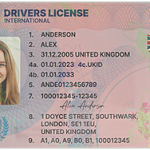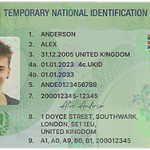Customs officials play a crucial and multi – faceted role in the detection of fake ID cards. Their responsibilities are not only important for national security but also for maintaining the integrity of international travel and trade systems.
### 1. The Initial Screening Process
Customs officials are often the first line of defense when it comes to identifying fake ID cards. At border control checkpoints, they conduct an initial visual inspection of ID cards presented by travelers. This visual inspection is a meticulous process that involves looking at various elements of the ID card. For example, they check the overall appearance of the card. Genuine ID cards usually have a high – quality finish, with well – defined edges and a smooth surface. Fake ID cards, on the other hand, may have rough edges or a sub – standard printing quality.
The color and texture of the card are also closely examined. Authentic ID cards typically use specific inks and materials that are difficult to replicate. For instance, some countries use holographic inks on their ID cards, which give off a distinct and unique shimmer when viewed from different angles. Customs officials are trained to recognize these tell – tale signs of authenticity.
### 2. Verification of Biometric Data
In the modern era, many ID cards come with biometric features such as fingerprints or facial recognition data. Customs officials have access to advanced technology to verify this biometric data. When a traveler presents an ID card with fingerprint data, for example, the official will use a fingerprint scanner to capture the traveler’s live fingerprint. This captured fingerprint is then compared to the one stored on the ID card.
If there is a mismatch, it could be a sign that the ID card is fake or has been tampered with. Facial recognition technology is also widely used. The customs official will compare the photograph on the ID card with the physical appearance of the traveler. This involves looking at details such as the shape of the face, the position of the eyes, nose, and mouth, and any unique facial features like moles or scars. Any significant discrepancies can trigger further investigation.
### 3. Cross – Referencing with Databases
Customs officials have access to extensive databases that contain information about genuine ID cards and known fake ID cases. When they suspect an ID card to be fake, they cross – reference the details on the card with these databases. For example, they check the ID number against a database of issued and valid ID numbers. If the ID number is not in the database or is associated with a different individual, it is a strong indication of a fake ID.
They also look for patterns of fraud. If there have been previous cases of fake ID cards with similar characteristics or from a particular region, customs officials can be on high alert. These databases are constantly updated with new information, allowing customs officials to stay informed about the latest trends in fake ID production.
### 4. Training and Expertise
Customs officials undergo extensive training to be able to detect fake ID cards effectively. This training includes learning about the different types of ID cards issued by various countries, their security features, and the methods used by counterfeiters to produce fake ones. They are trained in document analysis techniques, such as micro – scoping the ID card to look for any signs of alteration or forgery at a microscopic level.
They also receive training on human behavior and body language. A traveler with a fake ID may exhibit signs of nervousness or act in an unusual way when being questioned about their ID. Customs officials are taught to recognize these non – verbal cues and use them as part of their overall assessment.
### 5. Cooperation with Other Agencies
Customs officials do not work in isolation when it comes to detecting fake ID cards. They often cooperate with other law enforcement agencies, such as the police and immigration authorities. Information sharing between these agencies is crucial. For example, if the police have seized a batch of fake ID cards in a local raid, they will share details about the characteristics of these fake cards with the customs department.
This cooperation also extends to international agencies. In a globalized world, fake ID cards can be produced and circulated across borders. Customs officials may participate in international task forces and share intelligence with their counterparts in other countries to combat the production and distribution of fake ID cards on a larger scale.
### Common Problems and Solutions
#### Problem 1: Advancements in Counterfeiting Technology
Counterfeiters are constantly developing new and more sophisticated techniques to produce fake ID cards. They may use high – end printers and materials that are difficult to distinguish from the real ones at first glance.
**Solution**: Customs officials need to keep up – to – date with the latest counterfeiting techniques through continuous training programs. They should also invest in advanced detection equipment that can identify even the most subtle differences between genuine and fake ID cards. For example, using infrared scanners that can detect hidden security features not visible to the naked eye.
#### Problem 2: Traveler Resistance and Deception
Some travelers may be uncooperative when their ID cards are being inspected or may try to deceive customs officials. They may provide false information or try to distract the officials.
**Solution**: Customs officials should be trained in effective communication and conflict – resolution skills. They should be able to calmly and firmly handle uncooperative travelers while maintaining their focus on the ID card inspection. Clear signage and instructions at border control checkpoints can also help in setting the right expectations for travelers.
#### Problem 3: Overwhelming Workload
At busy border control points, customs officials may have to process a large number of travelers in a short period of time. This can make it difficult to conduct thorough ID card inspections on each individual.
**Solution**: Implementing automated systems for initial screening can help reduce the workload on customs officials. For example, using automated kiosks that can scan ID cards and perform basic authenticity checks. This can free up customs officials to focus on more in – depth inspections of suspect ID cards.
#### Problem 4: Incomplete or Inaccurate Databases
Databases used for cross – referencing ID card information may not always be up – to – date or may contain inaccuracies. This can lead to false positives or negatives in the detection process.
**Solution**: Regular audits and maintenance of databases are essential. Data should be updated in real – time as new ID cards are issued or as information about fake ID cases is discovered. Additionally, multiple databases can be cross – referenced to increase the accuracy of the information.
#### Problem 5: Language and Cultural Barriers
At international border control points, customs officials may encounter travelers from different cultural and linguistic backgrounds. This can make communication during the ID card inspection process challenging.
**Solution**: Providing language training to customs officials can help in overcoming this barrier. Additionally, using translation services or multilingual signage can assist in communicating with travelers. Cultural sensitivity training can also help customs officials understand and respect the different cultural norms of travelers, leading to a more harmonious inspection process.


